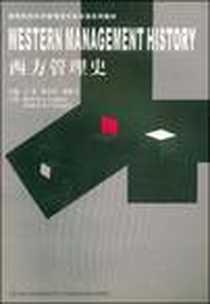《西方管理史》
《西方管理史》
出版时间:2005-8
出版社:武汉理工大学出版社
作者:于光
页数:487
《西方管理史》内容概要[E]
和平与发展是当今世界的两大主题。经济的发展,国力的增强,人民生活水平的提高已成为祖国建设的当务之急,因此管理学日益凸现其重要的指导意义。在这种情况下,学习、研究和应用管理学就很自然了。除去古代朴素的管理思想,这门科学,即真正意义上的现代管理学主要形成、发展和繁荣是在近现代西方。这本《西方管理史》的目的就在于提供一本较为系统、全面地介绍西方管理思想发展过程的教科书,以满足广大研究者、学生和管理实践者了解和理解这一过程的需要。本书的价值还在于这是一本用英语编写的教材,不仅在最大程度上保留了西方文化的底蕴,也为读者提高个人英语素养提供了有效的途径。编者一方面期盼本书能帮助读者系统地学习西方管理思想,从中受到启发教育,进而为发展适合我国国情的管理思想起到势砖引玉的作用,另一方面也希望广大学生和爱好者借此机会直接感受英语语言的魅力,适应全球化时代文化交流的需要。
《西方管理史》书籍目录[E]
CONTENTS PART Ⅰ The Earliest Beginning 1 Management in Ancient Civilizations
2 Management During the Middle Ages 3 A Managerial Awaking PART Ⅱ The Classical School of Management 1 Scientific Management
2 Administrative Management 3 Bureaucracy Management
4 Offshoots of Classic Management PART Ⅲ On Behavior Western Management Theories of Behavioral Sciences 1 Behavioral Sciences Theories 2 fiuman Relafions Theorles-Eatly Behavieral Selences
3 Individual Behavior Theories
4 Organizational Behavioral Theories PART Ⅳ The Modern Era Contemporary Western Management Theory 1 The Social System School
2 Decision Theory School 3 The Theory of Systems Management
4 The Empirical School 5 The Contingency (Situational) Approach
6 Management Science Supplementary Reading Appendix Appendix Ⅰ (附录Ⅰ)
Appendix Ⅱ (附录Ⅱ) Appendix Ⅲ (附录Ⅲ)
Appendix Ⅳ (附录Ⅳ) Appendix Ⅴ (附录Ⅴ) References
《西方管理史》章节摘录[E]
2.1 Feudalism and the Middle AgesRenaissance writers coined the phrase "Middle Ages" to refer to what occurred from the decline of Rome to the Renaissance period. Between about 600 and 1500——the rough opening and closing dates of the Middle Ages——too many different things happened to be characterized in any single way. The ideas and institutions of western civilization derive largely from the turbulent events of the Early Middle Ages and the rebirth of culture in later years. The Middle Ages may be studied profitably both for their own intrinsic interest and for the fundamental contributions they made to the development of the modern world.In the late Roman period, slavery became uneconomical: the upkeep of slaves was costly and they showed no particular enthusiasm for their work. The abolition of slavery came not with moral progress but with economic change. Development of free people as tenant farmers proved to be more economical. The growth of large estates and the political disorder following the fall of Rome led to economic, social, and political chaos, ripe for the emergence of the feudal system.Feudalism as a cultural system prevailed from about 600 C.E. to about 1500 C.E. At the base of the feudal system was the serf who tilled a plot of land owned by the manorial lord, much like modern sharecropper. Serfs were given military protection in exchange for a portion of the products of his labors. The feudal system tied people to the land, fixed rigid class distinctions, established an age of landed aristocracy that was to endure to the Industrial Revolution, forced education to a standstill, made poverty and ignorance the hallmark of the masses, and completely stifled human progress until the age of reformation. It is no wonder that some historians prefer to call this period "the Dark Ages".